As we celebrate the 100th anniversary of Women’s Suffrage in the United States, this series of posts puts the 19th amendment in context of our own ancestors.
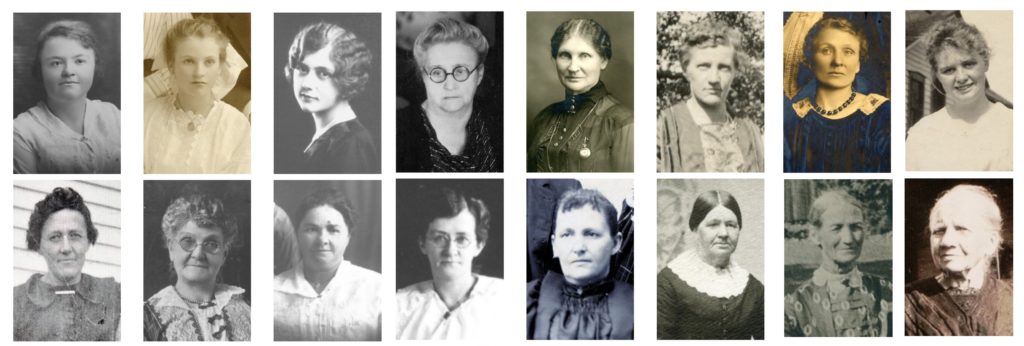
“The right of citizens of the United States to vote shall not be denied or abridged by the United States or by any State on account of sex.”
19th Amendment
This first post in the series introduces you to our sixteen female ancestors who were alive in the United States in 1920 when the 19th Amendment was signed on 26 Aug 1920.
Subsequent posts will cover efforts leading up to women getting full voting rights, elections in which our ladies were not to allowed to vote, the 1920 election, a special guest essay on one of our ladies, and struggles that remain long after 1920.
Our ladies
We had sixteen female ancestors who were alive in 1920 when the 19th Amendment came to be law. We can’t say how much this changed any of their lives, but for our ladies ranging in age from 16 to 76, the passing of the amendment ensured them an equal right that they had never before had.
- Alice Rosalie Fehlbaher Aschbrenner.
- Amelia “Millie” A. Brace Phillips.
- Barbara Mary Meyer Fawcett.
- Barebo Engebretsdtr Torset Christianson.
- Bertha Auguste Henriette Kluender Aschbrenner.
- Bertha H. Stemson Christianson.
- Caroline Hilson Aldahl.
- Clara Christina Elsabe Freese Lemke Boettcher.
- Frieda H. Lemke Krueger.
- Gertrude Lovin Boyce Phillips.
- Helen Lucina Baldwin Fawcett.
- Jane Elizabeth Cornell Miller.
- Leona Catherine Miller Phillips.
- Lona Iona Fawcett Estes.
- Margaret Olga Aldahl Christianson.
- Selma “Sally” Cornelia Aschbrenner Krueger.
Until this point in their lives, these women did not have full voting rights.
Maybe these ladies should have stayed in the old country?
Many of our female ancestors had deep roots in the United States. Had their families not left the United Kingdom of Great Britain and Ireland generations earlier, they would have been able to vote there in 1894.
Four of the sixteen ancestors we are profiling were immigrants themselves.
Barebo Engebretson Torset Christianson was born in Norway. Had she not emigrated from Norway, she could have voted in 1913.
Frieda H. Lemke Krueger, Clara Christina Elsabe Freese Lemke Boettcher, and Bertha Auguste Henriette Kluender Aschbrenner, were born in Germany. Had they not immigrated, they would have had Universal Suffrage in 1918, a couple years earlier than in the United States.
The United States of America was not the leader in women’s voting rights.
Bertha Auguste Henriette Kluender Aschbrenner
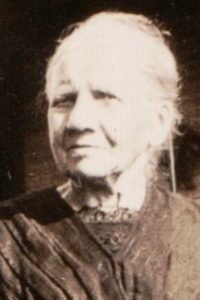
Bertha Auguste Henriette Kluender Aschbrenner, was 72-years old before women gained the right to vote. When she was born in Tutzluf, Germany, in 1848, King Frederick William IV of Prussia, ruled her country. There wasn’t any such place as Germany yet. At the time of her birth, James K. Polk was president of the United States and when she arrived in the United States in 1869, Ulysses S. Grant was president.
She married in 1871, shortly after her arrival to this country, to Civil War Veteran Frederick Wilhelm Aschbrenner, a widower with two daughters. Together, she and Frederick had twelve children, but sadly, only eight of them lived to adulthood. They settled at Town of Berlin, Marathon County, Wisconsin. By 1920, they had moved to another farm at Stratford, Marathon County, Wisconsin. Her children and step-daughters were all grown and had already produced 20 grandchildren. Most of their descendants lived relatively close, but son Sam was the only one still living at home.
Clara Christina Elsabe Freese Lemke Boettcher

Clara Christine Elsabe Freese Lemke Boettcher was 61-years old when the 19th Amendment was signed. When she was born in Grossen, Broda, Holstein, Germany, in 1859, James Buchanan was president of the USA. When she arrived in America, Chester A. Arthur was president.
Clara had married to Carl Lemke in Germany before her immigration. Together they had eight children. Four of those kids died young.
In 1920, she was on her second marriage. First husband, Carl, had disappeared in 1895 and she was granted a divorce at the end of 1896. She married her second husband, August F. Boettcher, in 1897. He was a widower bringing two kids to the marriage. Together, Clara and August had one son. That son was the only child still living at home in 1920.
Unlike most of our female ancestors of the time, Clara was a city-dweller with a job outside the home. She lived in Wausau, Marathon County, Wisconsin. She worked as a midwife. In 1920, she was very near the end of her 37-year career. She was still delivering babies, but not doing it full time.
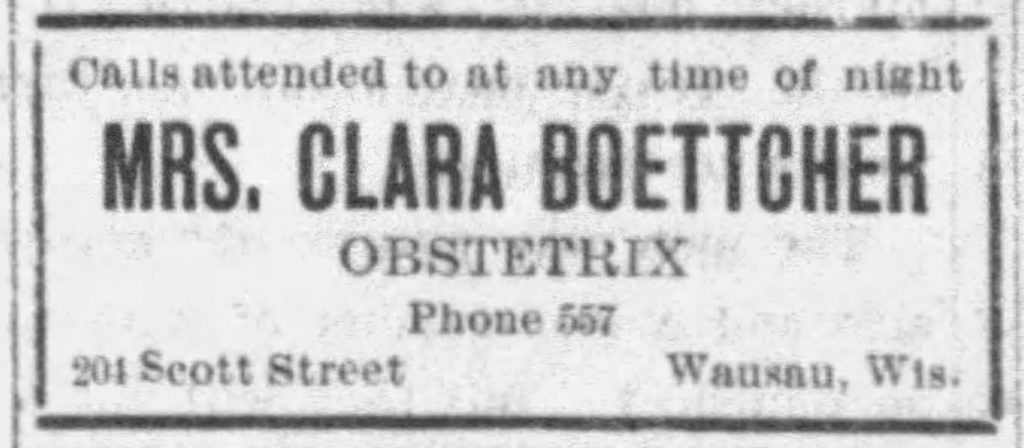
Frieda H. Lemke Krueger

When women gained the right to vote, Clara’s oldest daughter, Frieda H. Lemke Krueger was 39-years old. She was born in Hamburg, Germany, and had come to Wisconsin with her mother in 1882.
Frieda married in 1899 to Bernard Richard R. Krueger. They had all six of their kids by 1920. She was a homemaker in Wausau, Marathon County, Wisconsin, living just a couple miles from her mom. The Wisconsin River separated them. Frieda lived on the west side of town and Clara on the east.
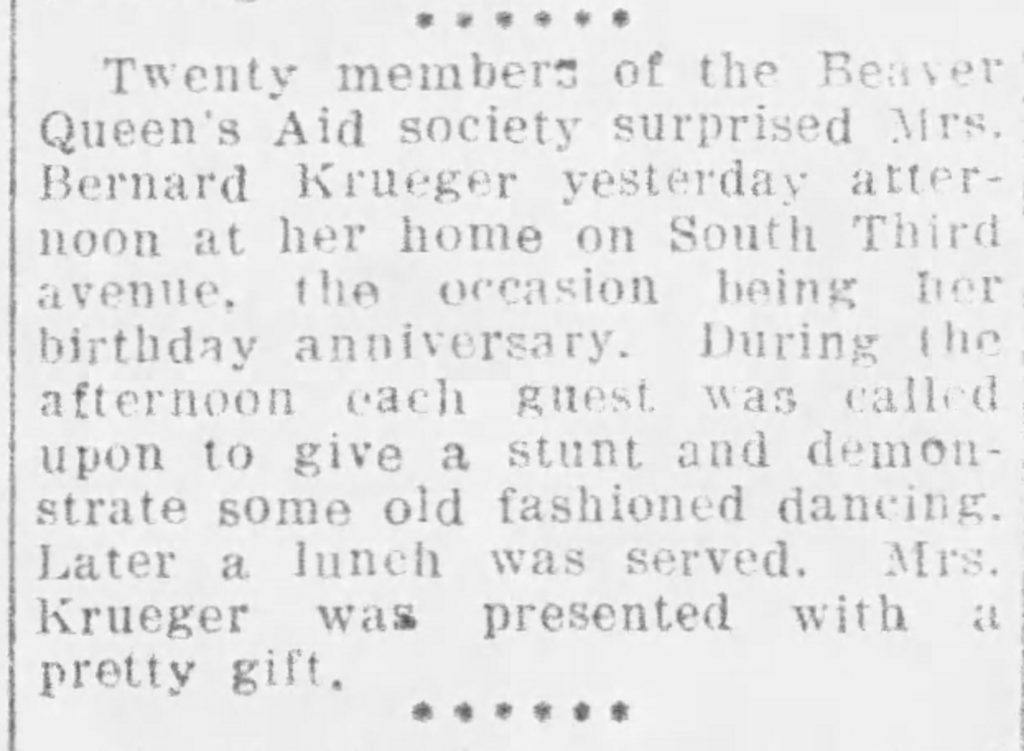
Barebo Engebretson Torset Christianson
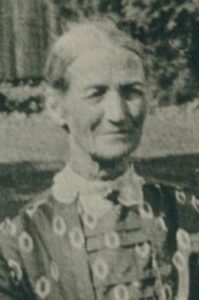
Barebo Engebretsdtr Torset was born in Norway, in 1848. King Oscar I of Sweden ruled Sweden and Norway when Barebo was born. He was followed by King Charles XV (or Karl IV as the Norwegians called him).
Barebo immigrated to America in 1864. Abraham Lincoln was president when she arrived. She married Björn Christianson Rukke, also known as Bennett Christianson, in 1870.
By 1920, her children were all well into adulthood. She and her husband still lived on their farm in Udolpho Township, Mower County, Minnesota. Their unmarried daughters Clara and Inga lived there too as did their youngest son Bennett and his young family.
Newlywed
Lona Iona Fawcett Estes
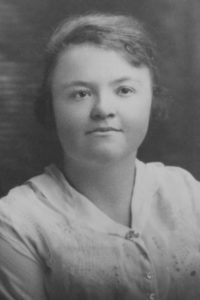
Lona was a newlywed in 1920. She married 30 September 1919 and in August 1920, she was expecting her first child who would be born at the very end of the year. An only child, she and her husband, Thomas Leland Estes, lived next door to her parents in Jackson Township, Sac County, Iowa.
She was only 18-years old at the time of the election. Even though women then finally had the right to vote, she’d have to wait a few more years until she turned 21. It wasn’t with the ratification of the 26th Amendment, on 01 July 1971, that people throughout the U.S. could vote at age 18.
By the time she was eligible to cast her first vote, she and her family had moved to Minnesota. She never talked about woman’s suffrage and the right to vote. But, she did use the right. It is suspected though, that she may have just voted for the Democratic candidate her husband suggested in any given election.
Single Ladies
In 1920, Leona, Sally and Margaret were still single ladies.
Leona got to vote in 1920. Sally was 16-years old and Margaret was 18. The two had to wait a few years to be old enough to vote.
Like Lona, these three were the first ancestors in their family trees to never have been denied the right to vote.
Leona Catherine Miller
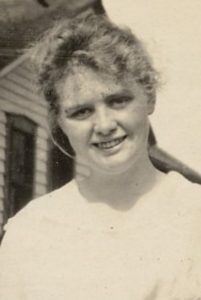
Of the single ladies, only Leona Catherine Miller was old enough to vote in the 1920 election. She turned 21 on 26 August 1920 , the same day that the 19th Amendment was signed!
In 1920, she was a high school graduate and still lived on the farm on which she was born. Her mom had died years earlier, so, as an only child, it was just she and her father on their Sandwich, De Kalb County, Illinois, farm.
Margaret Olga Aldahl
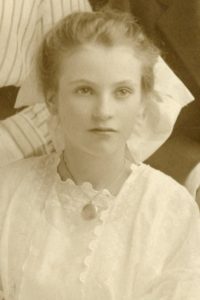
Margaret Olga Aldahl was a young adult in 1920, but not old enough to vote. She was done with school and lived on the home farm in Lansing Township, Mower County, Minnesota, with her parents, Lars and Caroline, three brothers, and three sisters. Earlier in 1920, she served as a sponsor at her nephew’s baptism. Family, household chores, and church likely consumed her life.
Selma “Sally” Cornelia Aschbrenner

Selma Cornelia Aschbrenner, known to us as Sally, was a high school student in 1920. Her parents Fred and Alice and little brother lived on a farm in Town of Berlin, Marathon County, Wisconsin. But Sally was living with an aunt and uncle in town, in Wausau, Marathon County, Wisconsin, so that she could attend school. She was taking the commercial course in high school, destined for a career in business.
American Born Wives
The rest of our women were born in the USA. They were all married women.
Alice Rosalie Fehlhaber Aschbrenner
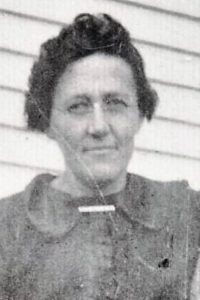
Sally’s mom, Alice Rosalie Fehlhaber, was born in Wisconsin in 1880. She was the daughter of German immigrants. She married Frederick A. Helmut Aschbrenner in 1902. His dad traveled on the same boat as Alice’s dad when they immigrated. Both families had settled in the Town of Berlin, Marathon County, Wisconsin. When Fred’s parents, Bertha Kluender and Frederick Aschbrenner moved from Town of Berlin to Stratford, Fred and Alice took over farming the original Aschbrenner homestead.
In 1920, Alice was 40-years old and still busy being a homemaker. Her oldest child, Sally, lived in the city of Wausau while she attended school, but her younger child was still at home on the farm.

Barbara Mary Meyer Fawcett
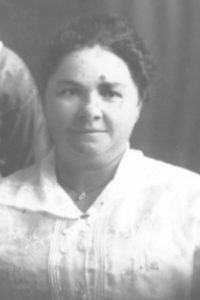
Lona’s mom too was the daughter of German immigrants. Barbara Mary Meyer was born in Illinois and moved with her parents to Sac County, Iowa, as a child. She married Harry Allen Lawrence Fawcett there in 1899. Lona was their only child, so their nest was empty in 1920 when Barbara was 39-years old. Though, their newlywed daughter and new son-in-law lived next door. Both couples would soon move north to Minnesota.
Barbara never talked about when women got the right to vote, but she did vote regularly – always for a Republican!
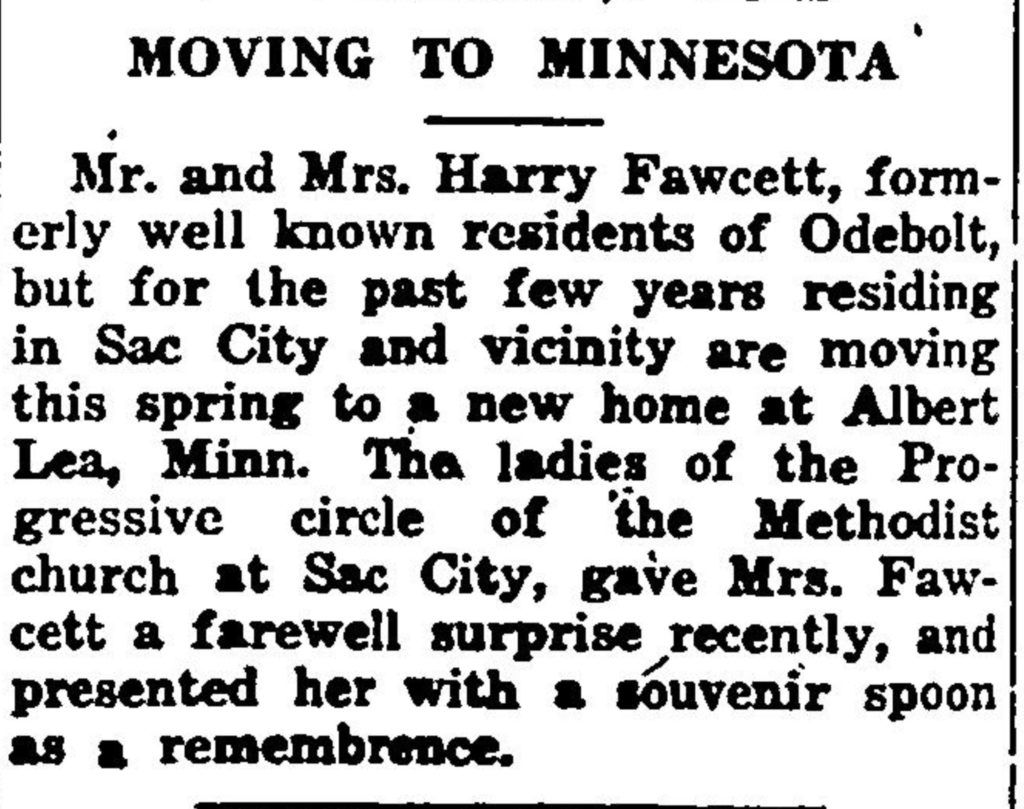
Helen Lucina Baldwin Fawcett
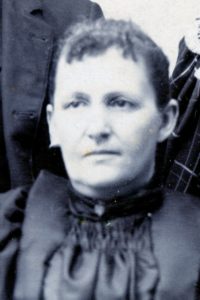
Barbara’s mother-in-law, Helen Lucina Baldwin, was descended from generations of Americans. Her grandfather was the founder Watertown, Jefferson, Wisconsin, so her mother had known the life of a pioneer. When she was young, Helen’s parents moved the family to Iowa. They moved around some, but were in Poweshiek County, Iowa, in 1869 when Helen married James Wood Huleress Fawcett. People called him “Hugh.”
Helen and Hugh had six children. The youngest child died at birth, and the oldest died at age fifteen. By 1920, their nest in Grinnell, Poweshiek County, Iowa, was empty.
She was born in 1855, so turned 65 soon after the 19th Amendment was ratified.
Jane Elizabeth Cornell Miller
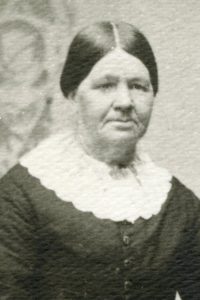
Like Helen, Jane Cornell knew a little bit about moving around. She was born in Michigan in 1853 and lost her mother young. She was raised by maternal grandparents. It wasn’t until she was a teenager that her dad sent for her to join him and his new wife in California. Jane was probably the only one of these ancestors who had seen the west coast by 1920.
While in California and still a teenager, Jane married George Leifheite Miller. He was over 20 years her senior. Soon after their marriage, they moved cross country, settling in Big Rock, Kane County, Illinois. If they’d stayed in California, she would have won the right to vote in 1911.
She and George had four children, including Leona’s dad, Frank. Jane was 67-years old in 1920, looking forward to celebrating a golden wedding anniversary the next spring. Their children had all left home by 1920 and George and Jane still lived on their farm in Big Rock.
Amelia Brace Phillips
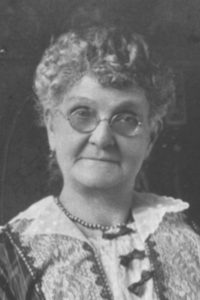
Amelia Brace was our oldest ancestor living at the time of the 19th Amendment. John Tyler was president when she was born. She was 76-years old in 1920, so was left out of a lot of elections during her lifetime.
Amelia, known as Millie, was born in Erie County, New York, in 1844, but was living in Bristol, Kendall County, Illinois, by 1850. She married Albert “Tom” Alvedo Phillips in about 1866. He was a Civil War Veteran. They raised seven sons on their farm.
By 1920, Millie and Tom were retired and living in town in Aurora, Kane County, Illinois.
Gertrude Lovin Boyce Phillips

Gertrude Boyce Phillips, Amelia’s daughter-in-law and Leona’s future mother-in-law, had deep American roots. She herself was 55-years old in 1920 and had missed getting to vote in many elections. Her female ancestors had been here for generations being restricted from the vote.
Gertrude was born in 1865 in Roxbury, Suffolk, Massachusetts, a suburb of Boston. When she was a child, her city folk parents packed up the family and moved to Blackberry, Kane County, Illinois, to be farmers. Sadly, her father died when she was young. Her mother moved to the town of Aurora, Kane, Illinois. Gertrude finished school and became a teacher.
In 1888, she married Guy Allison Phillips. They had five sons. Sons run in the family! They farmed in Kane County, Illinois, and had a second farm in Fannystelle, Manitoba, Canada, for a while. At the time of the 1920 Federal Census, two of her sons were back from World War I service, but only the youngest son lived at home with his parents in Illinois.
Women’s suffrage may not have been a highlight of Gertrude’s life. Her memoir, written in around 1952, had only one recollection of 1920.
One day in 1920 Florence and I called on a friend of hers two or so miles away. Soon after arriving more ladies called and told they had found a fur cape on the way in the road and that was my $75.00 lovely cape which I had put over the back of the carriage seat and had slipped out.
Gertrude Boyce Phillips, memoir.
Caroline Hilson Aldahl

Caroline Hilson, Margaret’s mother, was born in Westfield Township, Dodge County, Minnesota, in 1863. Her parents were both Norwegian immigrants. Caroline married Lars Olson Aldahl in 1885. Lars himself was a Norwegian immigrant. The couple started farming in Dodge County, but soon bought a farm in Lansing Township, Mower County, Minnesota. They had twelve children, though sadly, they lost one child, a five year old daughter, to drowning.
In 1920, Caroline was 57-years old and relieved to have her oldest son recently returned from the World War. Seven of her children still lived home on the farm.
Bertha H. Stemson Christianson
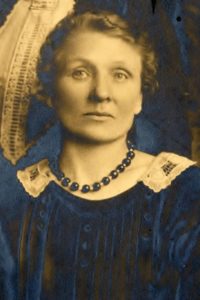
Margaret’s future mother-in-law, Bertha H. Stemson, also had Norwegian immigrant parents. Bertha was born in Newry Township, Freeborn County, Minnesota, in 1877. She married Barebo Engebretsdtr Torset’s son, Christian Bennett Christianson in 1898. They originally farmed in Newry Township, but by 1920, they had moved across the county line to a farm in Udolpho Township, Mower, Minnesota.
Bertha and Christian had eleven children. One son died in infancy. She was 43-years old and still busy having and raising kids in 1920. Her youngest son was born in February 1920.
Our female voters
The sixteen women we are profiling, were a cross-section of Midwestern America. They were farm wives, retirees, students, mothers, grandmothers, daughters, and even a midwife. Some were immigrants, some had deep American roots. They represent the American women who gained full voting rights when the 19th Amendment was signed.
Now that we know a bit about them, in the next post, we will take a step back to review how women finally gained full voting rights.
Where are they in the tree?
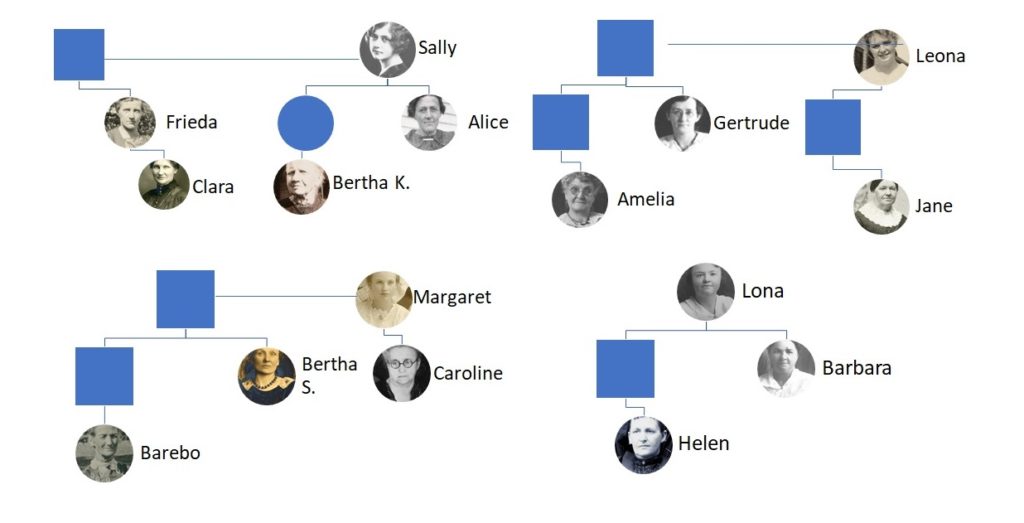
Selected Sources:
Christopher Klein, “The State Where Women Voted Long Before the 19th Amendment,” History, 01 Apr 2019 (https://www.history.com/news/the-state-where-women-voted-long-before-the-19th-amendment : accessed 07 Jul 2020).
“The Constitution: Amendments 11-27,” National Archives (https://www.archives.gov/founding-docs/amendments-11-27 : accessed 07 Jul 2020).


Leave a Reply